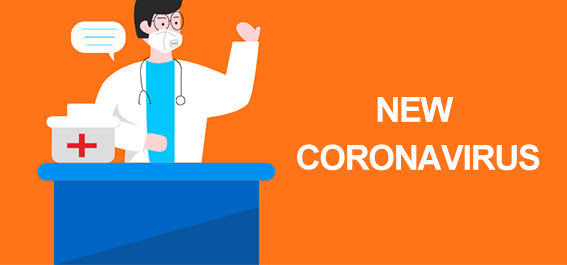
Knowledge of pneumonia infected by new coronavirus
1. What is a new coronavirus?
Coronavirus isolated from the lower respiratory tract of patients with unexplained pneumonia in Wuhan is a new coronavirus named WHO-2019-nCoV.
2. Who is susceptible to new coronaviruses?
The crowd is generally susceptible. New coronavirus-infected pneumonia can occur in both immunocompromised and normal immunocompetent people, and is related to the amount of virus exposure. For people with poor immune function, such as the elderly, pregnant women, or liver and kidney dysfunction, there are chronic patient groups, and the disease is more serious after infection.
3. What are the ways of spreading the new coronavirus?
The main modes of transmission are droplet transmission, contact transmission (including self-vaccination caused by hand pollution) and close-range transmission of respiratory aerosols of different sizes. At present, close-range droplet transmission should be the main route.
4. Will the new coronavirus be passed on from person to person?
meeting. Judging from the order of incidence of some clustered cases, the characteristics of person-to-person transmission are very obvious, and there is a certain range of community transmission.
5. What is droplet transmission?
Droplets: Generally considered to be water-containing particles with a diameter> 5um, the drops can enter the susceptible mucosal surface through a certain distance (generally 1 meter).
The generation of droplets:
(1) Cough, sneeze or talk
(2) Carry out invasive operation of the respiratory tract, such as sputum suction or endotracheal intubation, turning over, patting the back, etc. during coughing and cardiopulmonary resuscitation.
6. What is contact transmission?
Direct contact: Pathogens spread through direct contact with mucous membranes or skin
(1) Blood or bloody body fluids enter the human body through mucous membranes or broken skin
(2) Direct contact with secretions containing certain pathogens causes transmission
7. What are close contacts?
Refers to people who have lived or worked with a confirmed or highly suspected case of the virus within 14 days.
Including colleagues in the office, colleagues in the same classroom and dormitory, classmates, passengers on the same plane, etc. As well as other forms of direct contact, including the accompany of virus-infected patients, taking a taxi, taking an elevator, etc.
8. Matters needing attention for close contacts
All people who may have contact with a suspected infected patient (including medical staff) should have a 14-day health observation period. The observation period starts from the last day of contact with the patient. Seek medical attention as soon as any symptoms appear, especially fever, respiratory symptoms such as cough, shortness of breath, or diarrhea!
9. Monitoring suggestions for close contacts
(1) If the contact has symptoms, notify the hospital in advance and will go to the hospital.
(2) On the way to the hospital, patients should wear medical masks.
(3) Avoid taking public transportation, call an ambulance or use a private vehicle to transport the patient, and if possible, open the window on the road.
(4) Sick close contacts should always maintain respiratory hygiene and clean hands. When standing or sitting on the road and the hospital, stay away from other people as much as possible (at least 1 meter).
(5) Any surface contaminated by respiratory secretions or body fluids should be cleaned and disinfected with a disinfectant containing diluted bleach.
10. What are the clinical manifestations of patients with pneumonia infected by new coronavirus?
The onset of pneumonia caused by the new coronavirus is mainly manifested by fever. It may be combined with mild dry cough, fatigue, poor breathing, diarrhea and other symptoms. Runny nose, sputum and other symptoms are rare.
Some patients have mild onset symptoms, but no fever, only manifested as headache, palpitation, chest tightness, conjunctivitis, mild muscle pain in the limbs or lower back. Some patients developed dyspnea after one week, and in severe cases the disease progressed rapidly. Most patients have a good prognosis, and a few patients are critically ill or even die.
11. How to identify and observe pneumonia cases infected by new coronavirus in clinic
At the same time meet the following 2 conditions:
(1) Epidemiological history: patients who have traveled or lived in Wuhan within two weeks before the onset of the disease, or who had been exposed to fever and respiratory symptoms from Wuhan 14 days before the onset of the disease. Whether patients in sexual cases cause infections in others. A history of direct or indirect contact with related markets in Wuhan, especially the farmers' market.
(2) Clinical manifestations: Fever; imaging features of viral pneumonia; normal or decreased white blood cell count in the early stage of onset, or decreased lymphocyte count.
On the basis of observing cases, collecting respiratory specimens such as sputum and pharyngeal swabs for viral nucleic acid detection can make an etiological diagnosis.
12. Pneumonitis prevention and control measures for new coronavirus infection
• Standard precautions;
• Airborne prevention measures;
• Precautions for contact and spray: wash hands frequently and wear masks when going out;
• Room ventilation;
• Cleaning and disinfection: The new coronavirus is sensitive to heat. Soaking in 56 hot water for 30 minutes, 75% alcohol, chlorine-containing disinfectant, chloroform and other lipid solvents can effectively inactivate the virus.